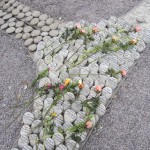Jun
17
A review of Sunday, June 13, 2010
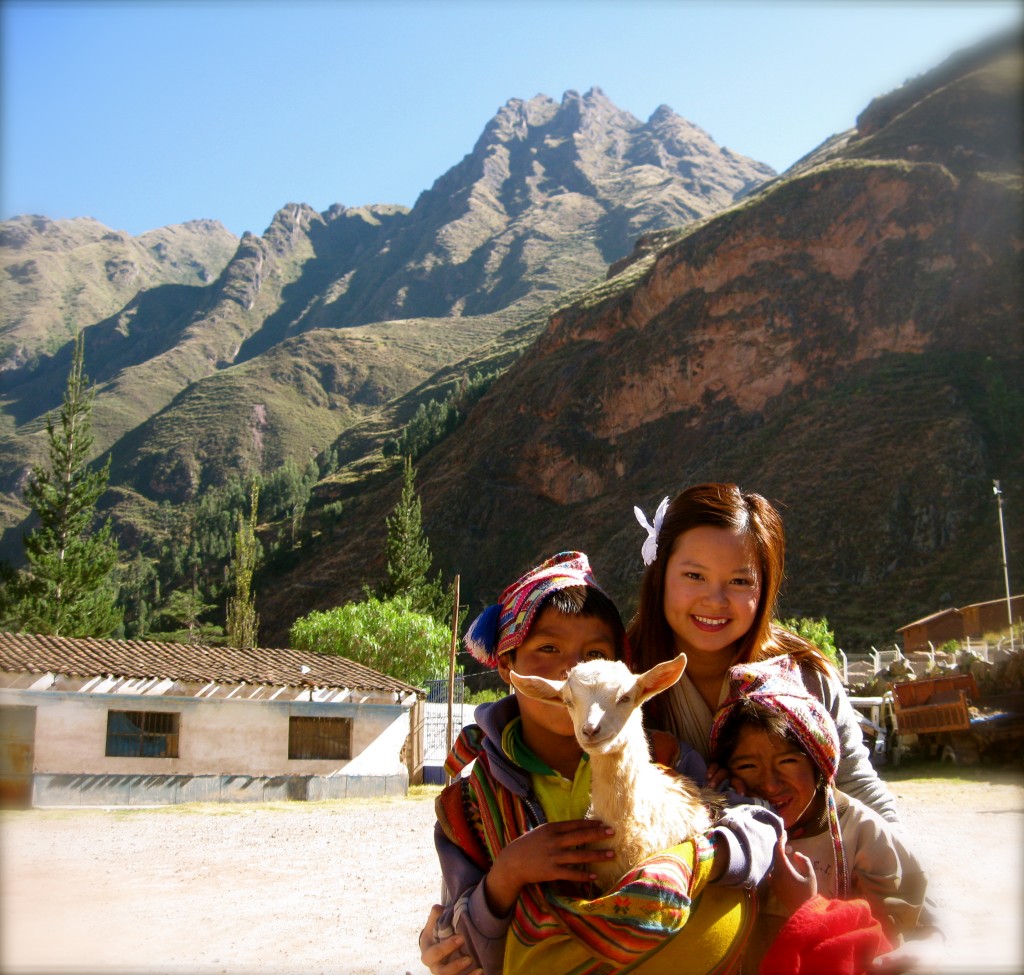
Almost everything costs money around tourist areas. I took a picture of two Andean boys (perhaps brothers) and their pet goat, and that cost me one sole each (about $0.40 each), but I did not mind paying. Maybe this is how the boys’ family pays for their schooling.
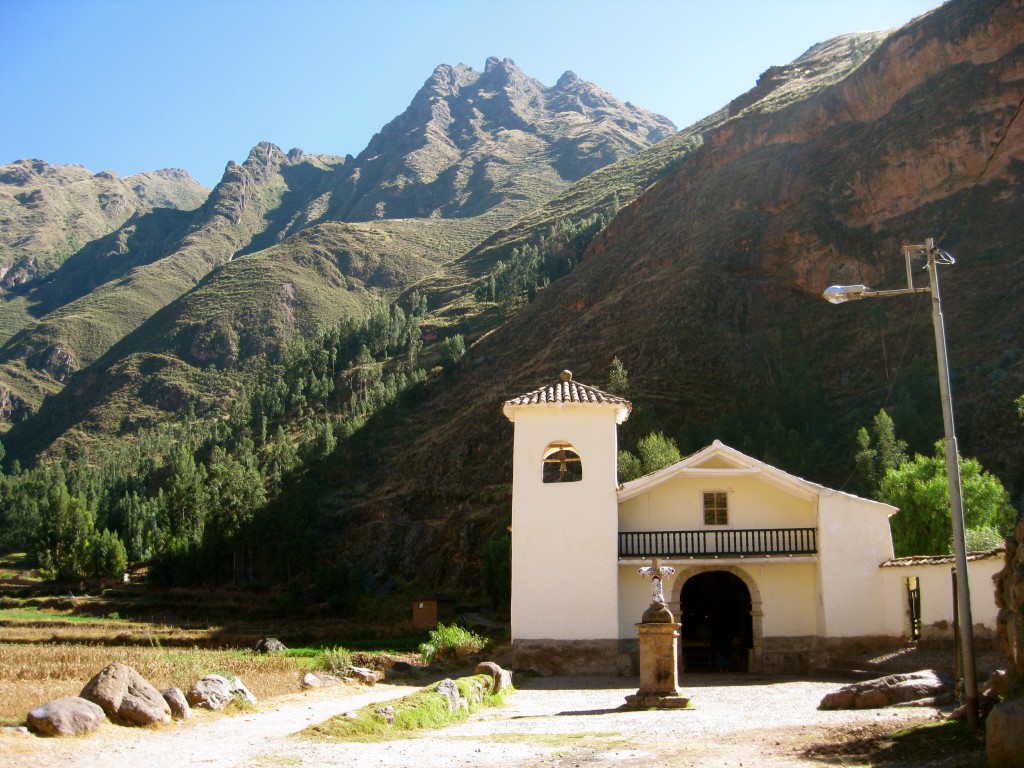
Lori, Rafael (our tour guide) and I found a small church down the street from the Pisac market for Mass. It was perfect for me because it was children’s Mass.
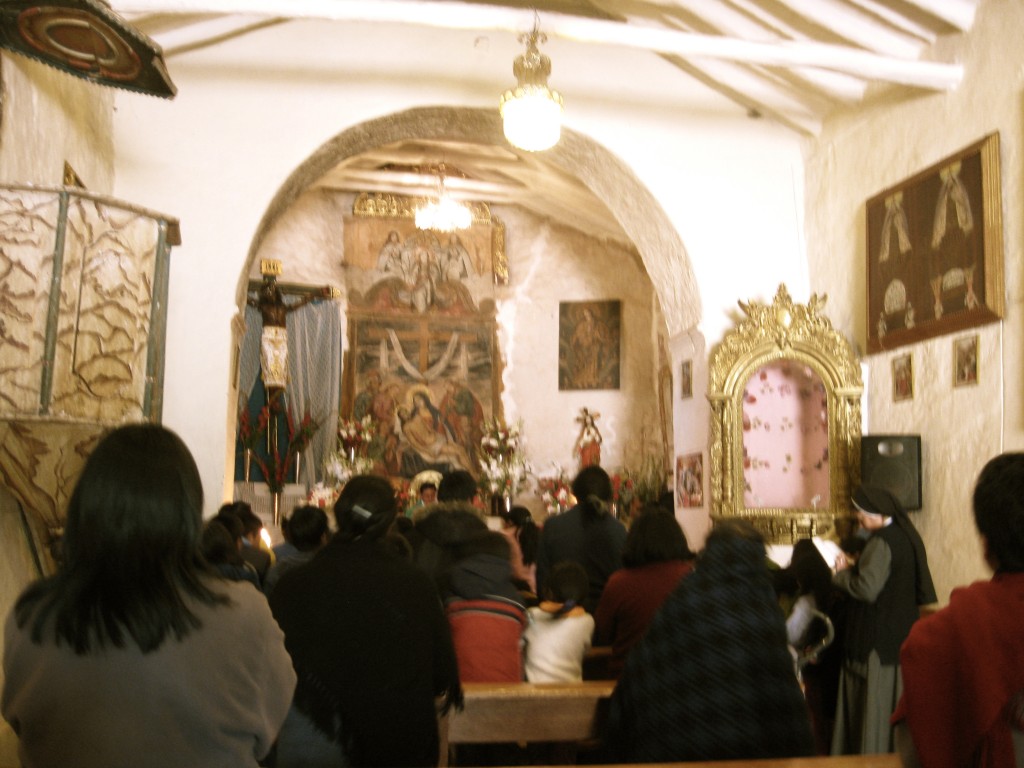
The majority of the congregation was children, but there was also a nun and three senior citizens. I have a big place in my heart for children and the elderly.

The three senior citizen women were physically weak and fragile. They could barely walk, and they were very skinny. All three had matching blue and black blankets that they used as covers for the cold.
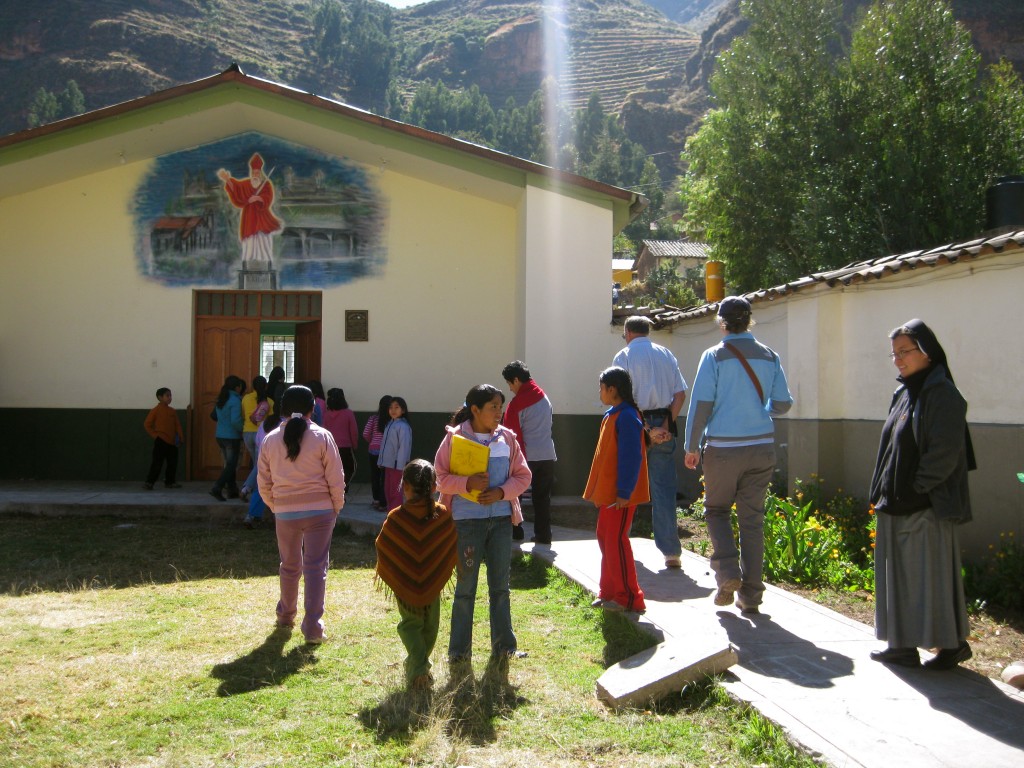
After mass, Rafael, Lori and I followed the nun and children to the “Comedor San Kilian,” St. Kilian church center and dining hall. Children of poorer families are able to go to Sunday school, confirmation class and eat here. This made my day!
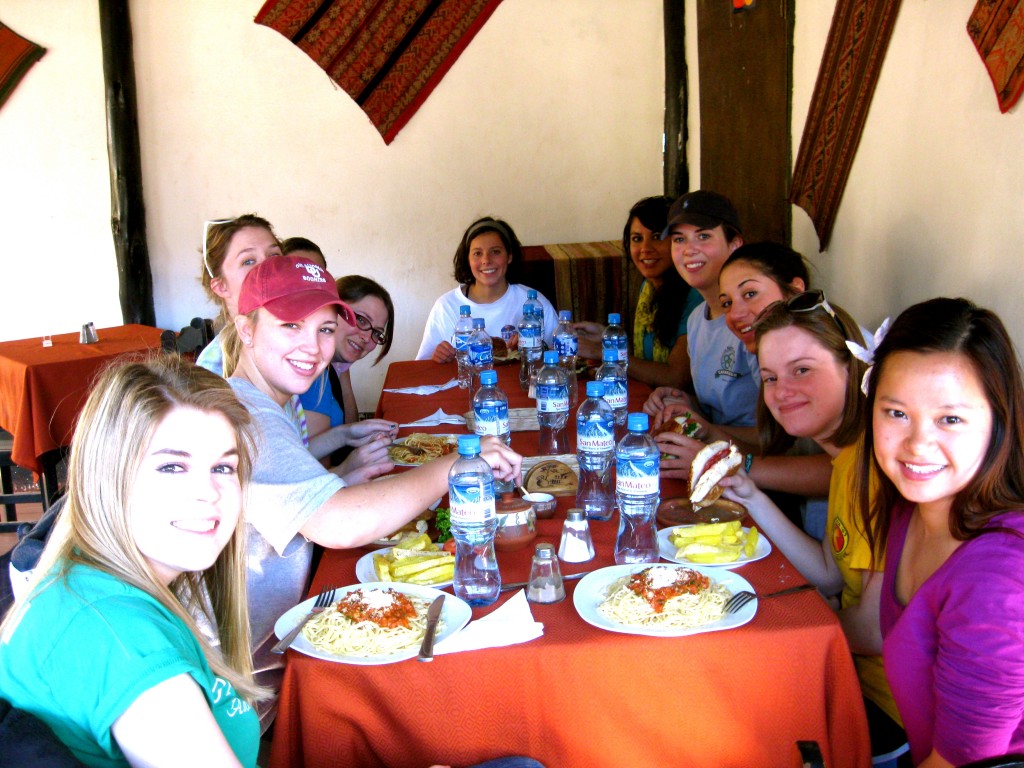
We ate a quick lunch on our own as soon as we arrived in Ollantaythambo at Pachacamac Pizzeria. I had “spaghetti napoleon,” which tasted like regular spaghetti, but with fresh sauce, parsley and mushrooms. We had to eat our food in 15 minutes.
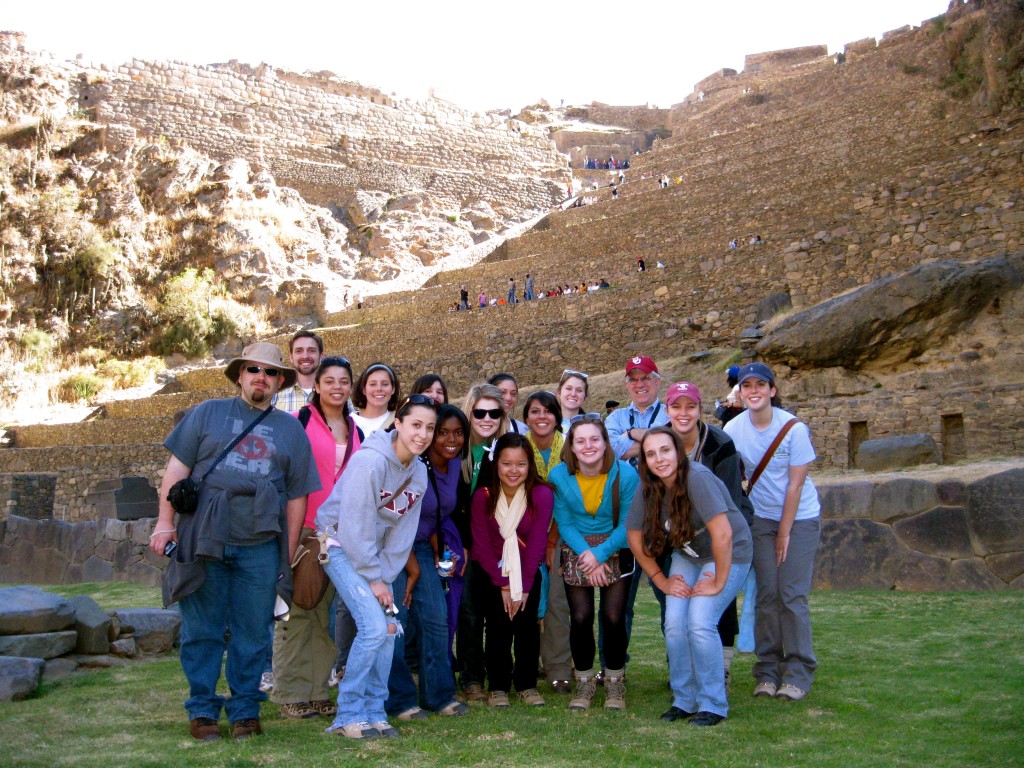
After quickly inhaling our food, we met up with the rest of OU Journey to Latin America members to hike up the Ollantaytambo ruins, the second ruins of the Incans.
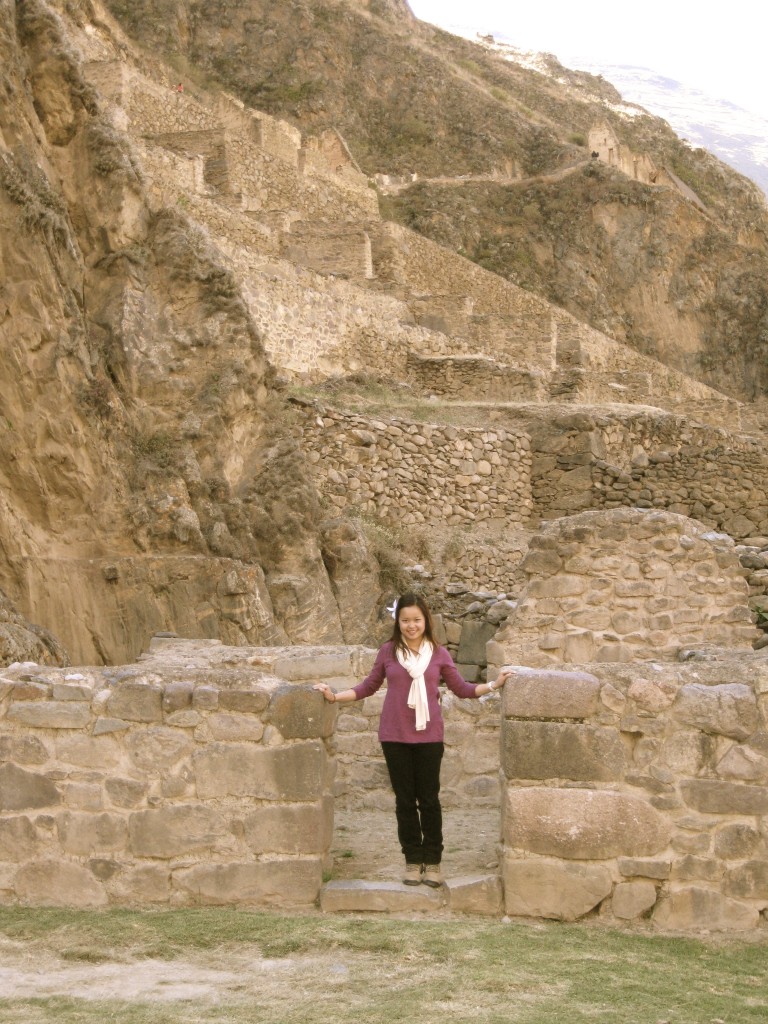
Saúl told us this area was considered the “Sacred Valley of the Incas” because there are glaciers at top of the mountains. The glaciers provide water, a source necessary for all life.
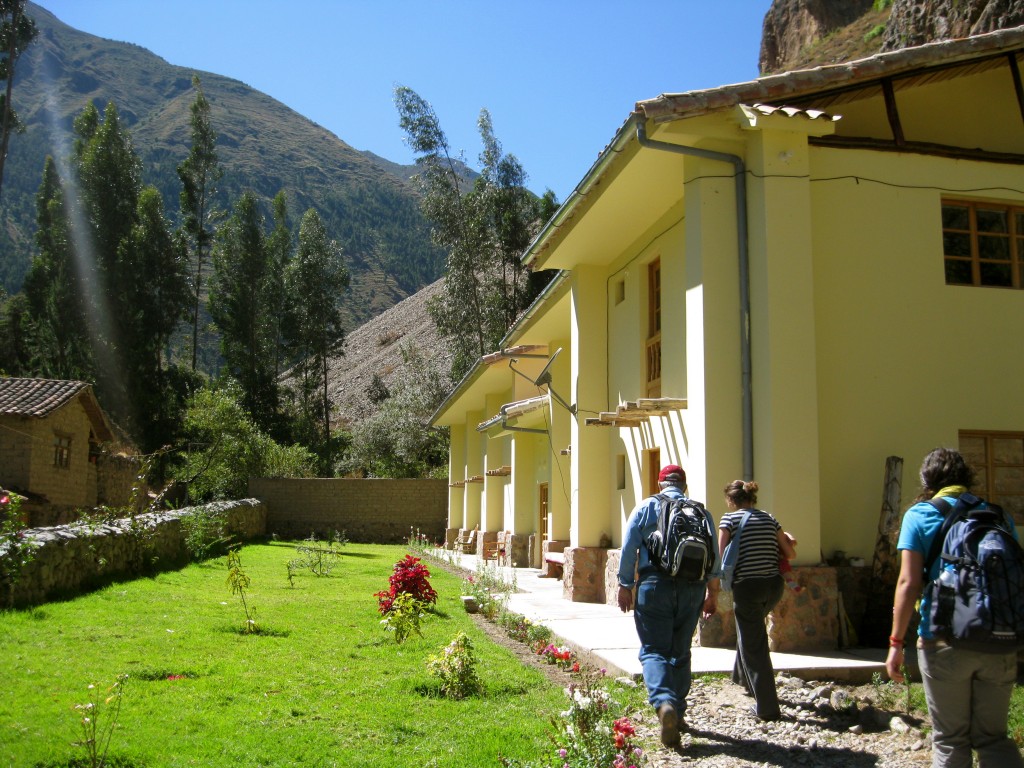
We stayed the night at the Apu Lodge, owned by a sweet family with two precious girls, and had class surrounded by ruins and Inca history.
I apologize for the 5-day hiatus due to lack of WiFi. I won’t be able to upload photos on the blog for a while because the WiFi at our current hotel does not allow it–just visualize with me until then. Please be patient as I attempt to catch up on blogging. 🙂
We have helpers for the Cuzco area: Rafael, a man in his 40s who goes with us everywhere for four days, and Saúl, 28-year-old tour guide. Rafael was so helpful in finding Mass and guiding us around the market. Saúl is a descendent of the Incas, born in Ollantaythambo, so he knows a lot about the Inca ruins. He is very passionate about the history and speaks English well. He’s also in very good shape from all his experiences, so it’s a fun challenge to keep up with him.
Lori, Rafael (our tour guide) and I found a small church down the street from the Pisac market for Mass. It was perfect for me because it was children’s Mass. The majority of the congregation was children, but there was also a nun and three senior citizens. I have a big place in my heart for children and the elderly.
The children were so happy to be in church, and they were singing and clapping. This Mass and church compared to the Mass and church of last week’s in Larcomar is completely different. Today’s Mass was lively, and I felt a sense of community. I saw many smiling faces, and everyone hugged for the sign of the peace. One boy hugged Lori and me. No one reached out to me at the mass in Larcomar, and hardly anyone shook hands.
The three senior citizen women were physically weak and fragile. They could barely walk, and they were very skinny. All three had matching blue and black blankets that they used as covers for the cold. Although they could barely move, they walked to Mass. I don’t know how far they walked to attend Mass, but they inspired me with their dedication to their faith.
After Mass, Rafael, Lori and I followed the nun and children to the “Comedor San Kilian,” St. Kilian church center and dining hall. Children of poorer families are able to go to Sunday school, confirmation class and eat here. This made my day!
I later walked around the famous Pisac Sunday market and bought souvenirs for family and friends. I bought six headbands for sorority sisters, a sweater and a dress made from Andean knitting (it even came with free hair ties), two fabric art pieces, a painting, two notepads with embossed leather covers and six postcards. I spent 113 soles, about $40.
Because I travel a lot, I know some natives try to take advantage of tourists by selling goods at much higher prices. For example, the original price of the leather notebook was 12 soles, but the woman was willing to sell me TWO for 10 soles at the end.
Almost everything costs money around tourist areas. I took a picture of two Andean boys (perhaps brothers) and their pet goat, and that cost me one sole each (about $0.40 each). Maybe this is how the boys’ family pays for their schooling. Even using the restroom costs money, but that’s how the owners make their money. After all, how do they pay for the water costs if they do not charge customers?
Many children were helping their parents at the market since it’s the weekend. A boy about the age of eight was running the restroom station alone. A 13-year-old girl sold clothes to me. We had a conversation in Spanish, and she told me she helps her mom. I never saw her mother.
We rode on the bus for about 1.5 hours from Pisac to Ollantaythambo. It was a bumpy ride, but it was nice to have time to journal and reflect on these amazing experiences. I have yet to soak this all in.
I’m still adjusting to the altitude change, but I’m no longer having trouble breathing. I have pressure in my head that causes a constant headache though.
It’s colder around these areas compared to Lima, so I have a running nose, sore throat and chapped lips. We ate a quick lunch on our own as soon as we arrived in Ollantaythambo. We ran into Saúl who suggested the Pachacamac Pizzeria. About 11 girls ate here, and I had “spaghetti napoleon,” which tasted like regular spaghetti, but with fresh sauce, parsley and mushrooms. We had to eat our food in 15 minutes.
After quickly inhaling our food, we met up with the rest of OU Journey to Latin America members to hike up the Ollantaytambo ruins, the second ruins of the Incans. Saúl guided us through this, and I felt very informed since this is his heritage and town.
Saúl told us this area was considered the “Sacred Valley of the Incas” because there are glaciers at top of the mountains. The glaciers provide water, a source necessary for all life. We also saw the “Temple of the Sun” and important storage houses. There is a face carved on the mountain next to the storage houses, built high up to keep things cool. How in the world was this face carved?
After the hike, Kim and I walked around the town and went inside the market. I wrote a few postcards until class.
We discussed Inca culture and watched a video of Machu Picchu produced by the History Channel. The video was very interesting and informative. This made us all very excited for Machu Picchu!
Yes, we have class on the go in hotels, lodges, wherever.
Ollantaythambo town has dark, narrow and uneven walkways lined with drainage and canine feces…it’s a challenge to walk around town!
After class, we had a Peruvian-style dinner buffet at Tawa Chaqui, across from the Ollantaythambo ancient ruins. It was delicious!
Skinny jeans are stylish…but not with hiking boots. We are all stylin’ in our hiking gear and backpacks!
We stayed the night at the Apu Lodge, owned by a sweet family with two precious girls, and having class surrounded by ruins and Inca history.
Jun
15
I mean, I can’t obviously give you THE answer. But I can talk about me!
I traveled in my first few weeks here for a weekend to Viña del Mar and Valparaíso. They’re two towns located on the coast, about 1.5 hours from Santiago; the bus ride between them takes about ten minutes. [OU also has an exchange program with the Universidad de Viña del Mar.]
This is Viña:
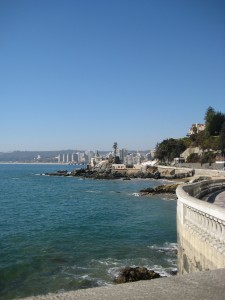
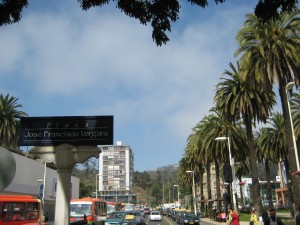
It’s a resort town, founded in the late 1800s by Santiago elites who wanted a summertime beach getaway.
This is Valpo:
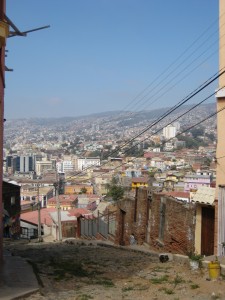
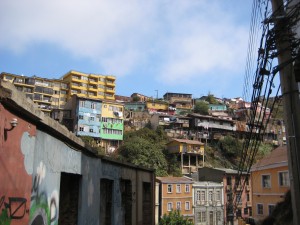
.
.
.
.
.
.
.
.
It’s a port town, historically economically critical and culturally vibrant.
.
Honestly, I didn’t like Viña very much. As far as I’m concerned, it was just like any other resort town (in any country): there are restaurants, and casinos, and big hotels, and artesanal/souvenir shops, and a beach (and a Museo de Arte Precolombino that we didn’t go to). It was fun and definitely nice to spend a day at the beach while it was still summer, but there was nothing distinctive about the town for me. Also, it’s probably relevant that casinos and big hotels aren’t really my preferred choice for spending money to entertain myself in the first place.
Valparaíso, though, I loved. The houses are all painted and hanging precariously off the city’s hills, there seem to be more stairs than sidewalks, there’s street art and murals everywhere, the port is still busy every day, and I just really enjoy spending time there. It’s different, and endlessly fascinating. I went back there on Saturday with two of my good friends from Norway, to visit Pablo Neruda’s house (La Sebastiana) and conocer (lit. meet, know, be familiar with — a very elegant little verb) more of the city. It was great.
Most of my Brasilian friends, though, hated Valpo (and really liked Viña), saying, “It’s dirty. It’s falling apart. It looks like a favela (slum). We didn’t come here to Chile to see poverty; we already know that*. We came to see richness.”
*To be clear, I’m not saying that all (or most) Brasilians are impoverished (in fact, the poverty rate has declined by about 60% in the past decade). However, the 1980s-90s were economically extremely difficult for Brasil, and the continuing enormous income inequality in the country makes poverty there much more visible than in Chile.
So, how do I/should I react to that? What does that say about what I came to South America for? There are obviously several other justifications I could provide for my preference of cities (see above), but it’s these little remarks that slap me in the face, over and over, with how often I take for granted or just plainly don’t think about the basic inequality (economic and otherwise) that separates me from most of the rest of the world. It’s horrible, and thinking about it is one of the easiest ways to ruin my day — because not only is it unfair and unjust in its own right, but it also generally ends with me feeling crushingly guilty for having so unwittingly benefited from a global economic system that I have zero control over.
Does this preference for Valparaíso then peg me as just another gringa looking to gawk at a “less-developed” country (at least stereotypically)? Is it patronizing of me just to be interested? At any rate, my desire to travel there seems to be driven by its difference from any city I’ve been to in the US, which certainly says something in itself.
And this is the part where I should write a post devoted to recognizing and elaborating and analyzing my privilege: as a United States citizen (more generally, as a “Westerner”), as a university student with a great scholarship whose parents are still paying her way, as a student with the financial and academic resources to study abroad at all, to name a few (there are many more, not the least of which is just being a white, straight girl from an upper-middle class family).
Unfortunately, because of time constraints, it’s not going to happen today.
Instead, with all this in mind and on my mind, I’m off to Bolivia!
Jun
15
I know I promised a “food blog” from my Machu Picchu/Cusco trip. It will come!!!! But first I wanted to blog about some of the amazing experiences I’ve been having lately learning about Peru’s history.
My favorite course here at Católica is called “Justicia y Organismos Públicos” taught by Jo Marie Burt. Profesora Burt is a visiting professor from George Mason. In class, we’ve been studying transitional justice.
Transitional justice is a response to systematic or widespread violations of human rights. It seeks recognition for victims and to promote possibilities for peace, reconciliation and democracy. Transitional justice is not a special form of justice but justice adapted to societies transforming themselves after a period of pervasive human rights abuse.http://www.ictj.org/en/tj/
If you do not know much about this time period in Peru (as I didn’t when I first arrived), I highly highly recommend reading about. Here’s the wikipedia link–it really doesn’t do it justice.
http://en.wikipedia.org/wiki/Internal_conflict_in_Peru
I feel like basically, the easy/common thing to do is blame all the human rights violations on Sendero Luminoso (Shining Path–maoist, guerilla, terrorist group started by a professor at an Ayacuchan university named Abimael Guzman (their leader captured in 1992). The Senderistas wanted to take over the government and make a “New Democracy.” They went to the rural, indigenous areas to gain support, highlighting the failures of the current regime and boasting change for the better.) It is true that SL was responsible for many many many violations–massacres, disappearances, torture, sexual violations.. However, according to the CVR (the Truth and Reconciliation Commission in Peru), the Senderistas were responsible for 54%, the MRTA (Túpac Amaru Revolutionary Movement) was responsible for 1.5%,and the Peruvian armed forces were responsible for 37%.
Some specific cases if you would like to learn more “Cantuta Massacre” “Barrios Altos Massacre” “Putis”–all committed by the armed forces. “Uchuraccay Massacre” where journalists were killed in Ayacucho. “Tarata Bombing” “Lucanmarca Massacre” “Assassination of María Elena Moyano” carried out by the Shining Path. The Peruvian government was ill-prepared to fight the Senderos and their guerrilla war. The rural, indigenous, quechua speakers got the brunt of the impact. 79% of the victims were from rural areas (only 29% of Peru’s entire population lives in rural areas). 75% of the victims spoke Quechua or other native language as thir primary language (Only 16% or Peru’s population speaks a native language as their first.) These statistics show how lopsided the violations were. Statistics given in class–time period: 1980-2000.
69,000 deaths
14,000 forced disappearances,
600,000 displaced persons
4-5,000 arrests without justification
A couple of weeks ago, our professor was out of town. Instead of going to class, she asked us to visit Yuyanapaq, a photographic memorial to the victims of the armed conflict. Yuyanapaq means “para recordar” or “to remember” in Quechua. Here’s a link to a random blog I found that has pictures of the memorial-with captions from the blogger (I didn’t think to bring my camera):
http://c-monster.net/blog1/2009/06/08/yuyapanaq/
The memorial did an incredible job of making history come to life. Words cannot describe what an impact it had on me. And today, I was fortunate enough to receive a publication of the memorial that includes the majority, if not all, of the the pictures with captions. My teacher brought them to class!! Yuyanapaq is awesome–a great way to memorialize the conflict and its victims. The exhibit evokes many strong emotions and serves as a place for Peruvians to remember and contemplate their history–as well as for foreigners to learn about it. One photo in particular had a strong effect on me. It was a black and white of the Pan American Highway with tons of rocks on it and a combi off to the side. The rocks formed a roadblock for the combi and the senderos killed everyone on the combi. It struck me hard. I have traveled on the Pan American before in a combi just like the one depicted. The conflict during which this picture was taken ended a mere 10 years ago. It is still very fresh in the minds of those who lived through it. Yuyanpaq brought history to life for me and made it personal. I will never forget the atrocities that occurred here in Peru…ever.
On Saturday, June 5, Calin and I visited the Ojo Que Llora monument in Campo Marte (park in Lima). This is a monument by an artist named Lika Mutal, who was born in Holland but has lived in Peru for 40 years. Mutual inspiration for the monument was her visit to Yuyanapaq. The monument consists of a maze of around 47,000 stones that used to have the names of 27,000 victims on them (taken from an official list). Visitors are meant to follow the maze of stones from inside out until they come face to face with Mother Earth or Pachamama in the center. She is represented as an eye perpetually crying–a stream of water continually flows from this sculpture. The monument was funded by private donations. There is a huge debate about this monument–basically about how to distinguish “victims” from “perpetrators”. Many believe that among the rocks, are names of both. The monument was defaced once in 2007 when news of Fujimori´s extradition surfaced. The persons responsible for this attacked a guard at the monument, smashed several rocks, and left neon orange paint all over the monument. The sun and weather have washed away all the original names on the rocks (painted with permanent ink), and now the rocks are being inscribed and placed in a series of ceremonies.
The day after we visited “El Ojo que Llora,” I attended a group meeting for a project in Justicia class. Our group met with members of EPAF (Equipo Peruano de Antropología Forense).http://epafperu.org/ We discussed the case we´ve been researching–El Caso de Putis. This event occurred in December 1984 in the region of Huanta. In this region, there had been high sendero presence. Many of the people living in the region, had fled to the mountains and forests to hide in 1983. A military base was installed in 1984. The armed forces asked the villagers to come out of hiding, promising protection from the Senderos. When the villagers returned, the military led them to a site under the pretense of making a piscigranja or fish farm to aid in the redevelopment of their town. The men started digging, and when they had finished, the all of the villagers lined up around the holes for the fish farm. The military proceeded to shoot all 123 of them–men, women, and children (many many many innocent children–the youngest was only 1 year old). Basically the villagers had dug their own grave. The CVR–truth and justice commission of Peru–investigated this case and confirmed that these events occurred. They found two graves, one in 2001 and the other in 2003. These graves were not exhumed until 2008–24 years after the massacre had occurred. EPAF helped with the exhumation, conducting tests with DNA and identifying the bones, clothes, and other possessions within the graves. They also found bullets with the markings of the armed forces inside. The testimonies of the CVR and the evidence from the exhumation matched perfectly. (Exhumations are only allowed in Peru if the case is being brought to court) However, there is still no justice for the case of the Putis. To find out why my group believes why you can read our essay. (I will try to attach it later)
While talking to members of EPAF, we touched on the subject of memory. I gave the example of September 11: For my children, it will “just” another part of history. How will they understand the importance or impact of what happened? EPAF emphasized that this is the importance of their work–not only to help with exhumations and run tests and analyze data but ALSO to make sure people don´t forget.
I believe this is the importance of memorials like Yuyanapaq and El Ojo que Llora–to FORCE people to remember what happened so that it won´t happen again. I like the way a guest professor to our class put it best in these few statements (he was talking about film, but it still applies:) ) :
–>The images call us to reflect and analyze what we see.
–>They give new generations the possibility to have a memory so they can investigate the events so they can turn “myths” into history.
Jun
12
A review of Saturday, June 12, 2010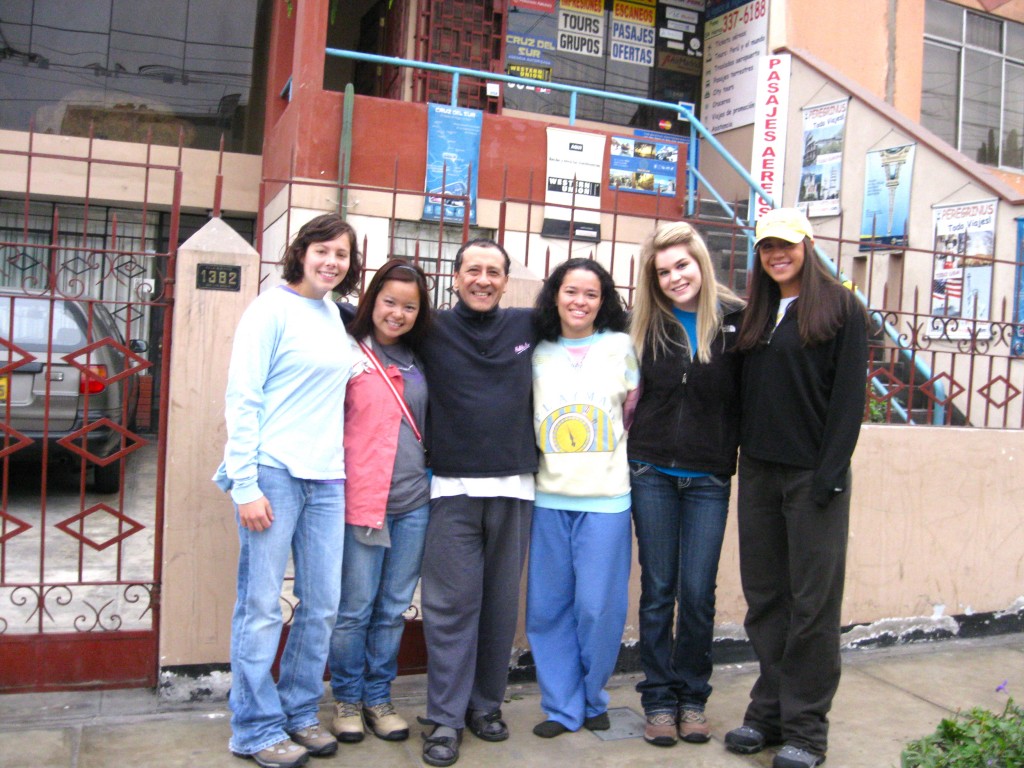
- We all learned we had become attached to our host family because it was very difficult to say good-bye. They were beyond wonderful to us. They want to continue these relationships, and we all exchanged contact information. Left to right: Jane, Chinh (me), Ricardo (host dad), Esther (host mom), Kim and Carlee in front of our four-story host home in Lima.

We didn’t have any trouble in the Lima airport, and the security process went smoothly. We even conquered a corner of the airport like in the history we have learned about for this class!
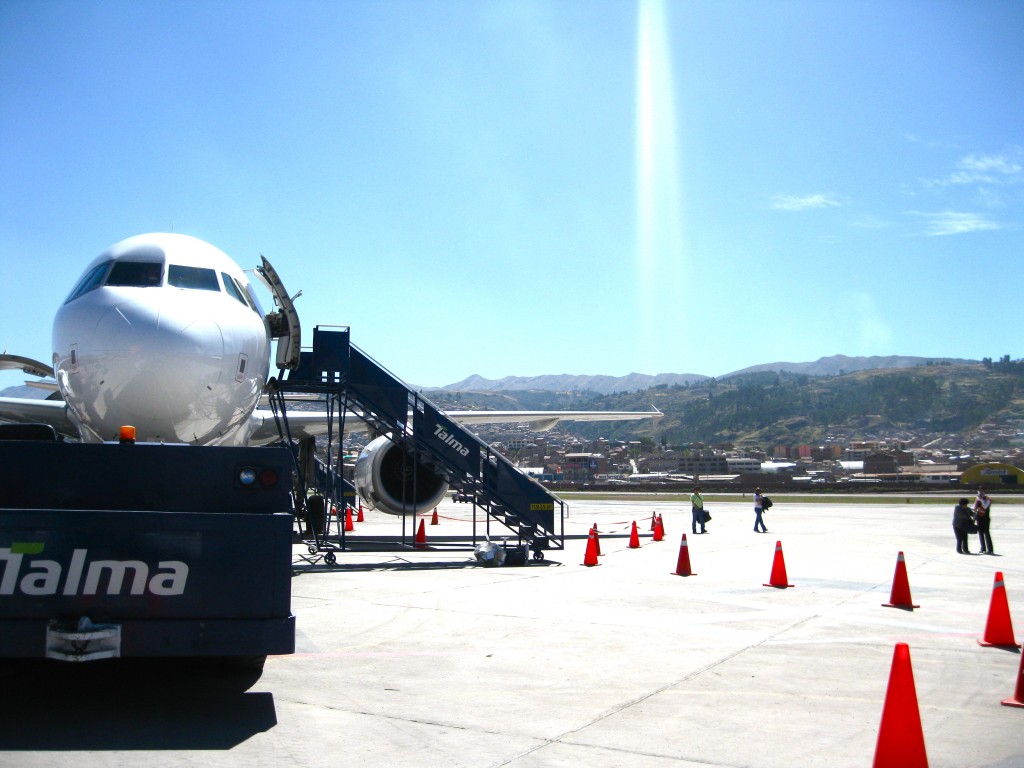
We had a great flight from Lima to Cuzco with awesome snacks: crackers, Twinkie-like cake and chocolate. The flight took about an hour. The coolest part of the flight was being able to walk out of the plane into Cuzco air and seeing beautiful mountains.
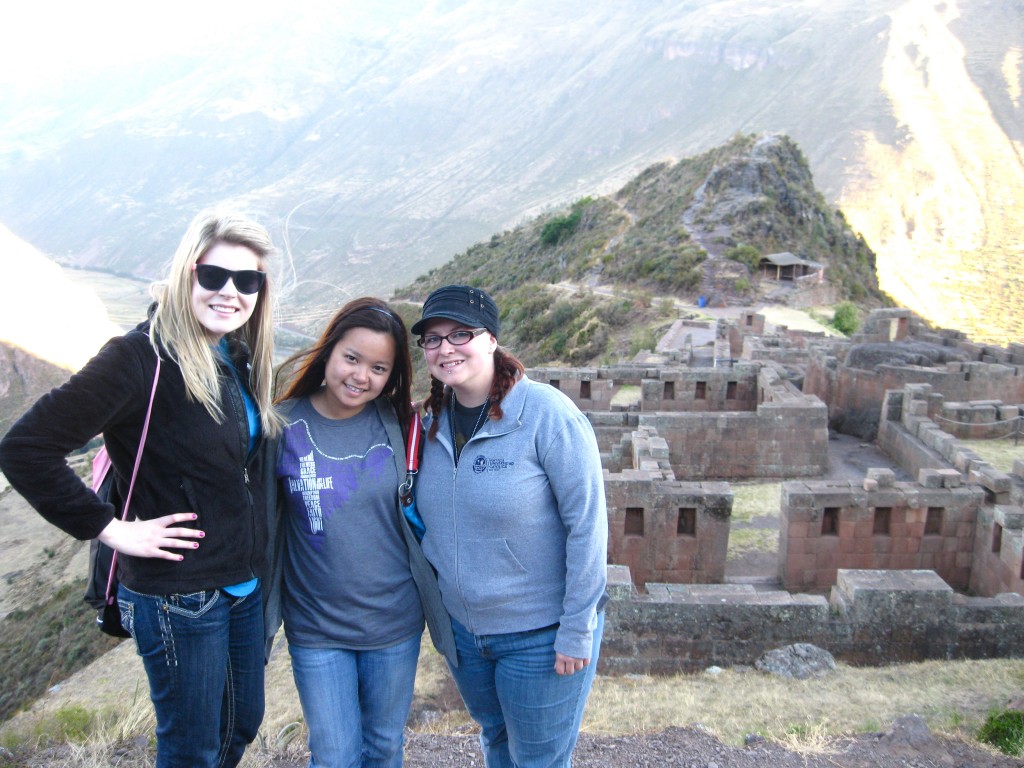
We drove up the mountains and stopped twice for pictures of the Cuzco valley and Inca valley. We later climbed down Pisac (the first Inca ruins) for 2.5 hours. Left to right: Kim, Chinh (me) and Ravae took a picture in front of the Pisac ruins.
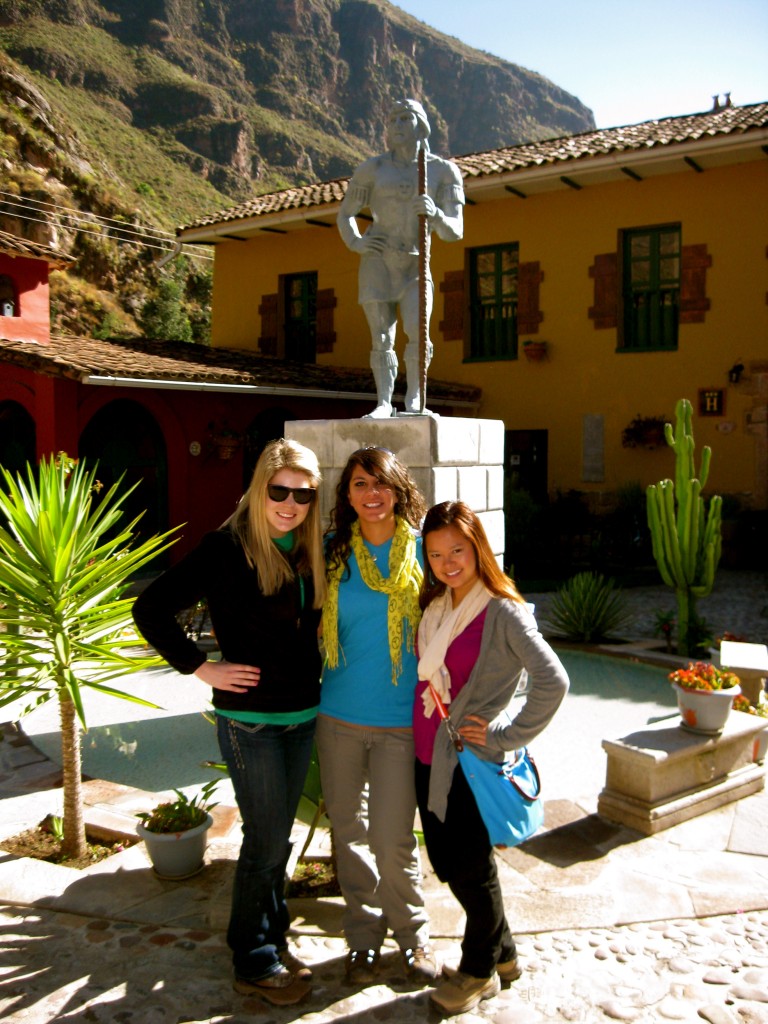
We are staying at the Royal Inka Hotel--it's SO cool to be surrounded by mountains! There's WiFi, pretty gardens, sauna, jacuzzi AND hot water!
Carlee, Jane, Kim, Señora Marchand (my Spanish teacher and Dr. Kenney’s wife) and I were ready to go to the airport at 7 a.m. Dr. Kenney went ahead to the airport because he went with three students (Katherine, Ryan and Whitlee) who had an earlier flight. We ate a light breakfast at the host home before we bid them farewell.
We all learned we had become attached to our host family because it was very difficult to say good-bye. They were beyond wonderful to us. They want to continue these relationships, and we all exchanged contact information.
We gave them our thank-you gifts. I brought OU slippers for the host mom, potholder and card case for the host grandmother, light-up pen and musical keychain for the host dad and notepads for the two sons. Our host family gave us chocolate-covered almonds and pens.
We didn’t have any trouble in the Lima airport, and the security process went smoothly. We even conquered a corner of the airport like in the history books we have read for this class!
We had a great flight from Lima to Cuzco with awesome snacks: crackers, Twinkie-like cake and chocolate. The flight took about an hour. The coolest part of the flight was being able to walk out of the plane into Cuzco air and seeing beautiful mountains.
I’ve never been this high in the mountains before so I was having trouble breathing. My heart was racing and my head had a lot of pressure; I felt like everything was in slow motion. But after about an hour, I adapted to it and felt fine. No one else seemed to have any trouble adjusting.
We dragged so our luggage around the narrow walkways of Cuzco while cars drove by faster than they do in Lima!
We drove up the mountains and stopped twice for pictures of the Cuzco valley and Inca valley. We later climbed down Pisac (the first Inca ruins) for 2.5 hours–my body hurts! It’s interesting to see irrigation and the paths walked on by humans thousands of years ago. I was having trouble and slipped in my hiking boots. How did the Incans move about all in sandals with no support? The steps are very steep; most students found them difficult to walk on, yet the Incans were much shorter and managed fine. How did they do it? Props to them!
We barely made it down by dark. It was getting scary because we could not see very well, yet the walkway is narrow and dangerous.
We walked through the closed market, but I found some indigenous babies. I spoke to them in Spanish, and they understood. I later sat on a corner, and one of the children came to sit with me and held my hand. I can’t wait to play with more babies later on this trip!
We had bread, potato soup and Peruvian pizza at Ulrike’s Café in Pisac. We ate SO much. The flavors ranged from pineapple and ham to meat and mushrooms.
We are staying at the Royal Inka Hotel–it’s SO cool! There’s WiFi, pretty gardens, a sauna, a jacuzzi AND hot water! We are going to continue to have class even while traveling, but it will be at different times and wherever we can. It’s not ALL fun and games; gotta have education, too!
OU Journey to Latin American students finished class at 10:05 p.m. in Pisac (about a one-hour drive from Cuzco), Peru. Is this real life? This study abroad trip is not only different than traditional classroom settings, but it’s different than other study abroad trips.
We have the opportunity to learn about the subject before the trip during bi-weekly meetings and have classes on the road during the trip. This is nice because we learn about our activities day-to-day so we retain the information more rather than cramming it all in at once. Plus, we get to participate in what we learn about so it’s more fun!
Oh, and Hello Kitty iPhone fell in the toilet in our Pisac hotel. As I swung my arms in an attempt to turn on the light, Hello Kitty dove into the Peruvian waters of the (clean) toilet. Good thing Hello Kitty has nine lives; I’ve used two of those lives already!
I am rooming with Kim and Jane (housemates from Lima). We are exhausted and ready to sleep for more adventures tomorrow!
Jun
11
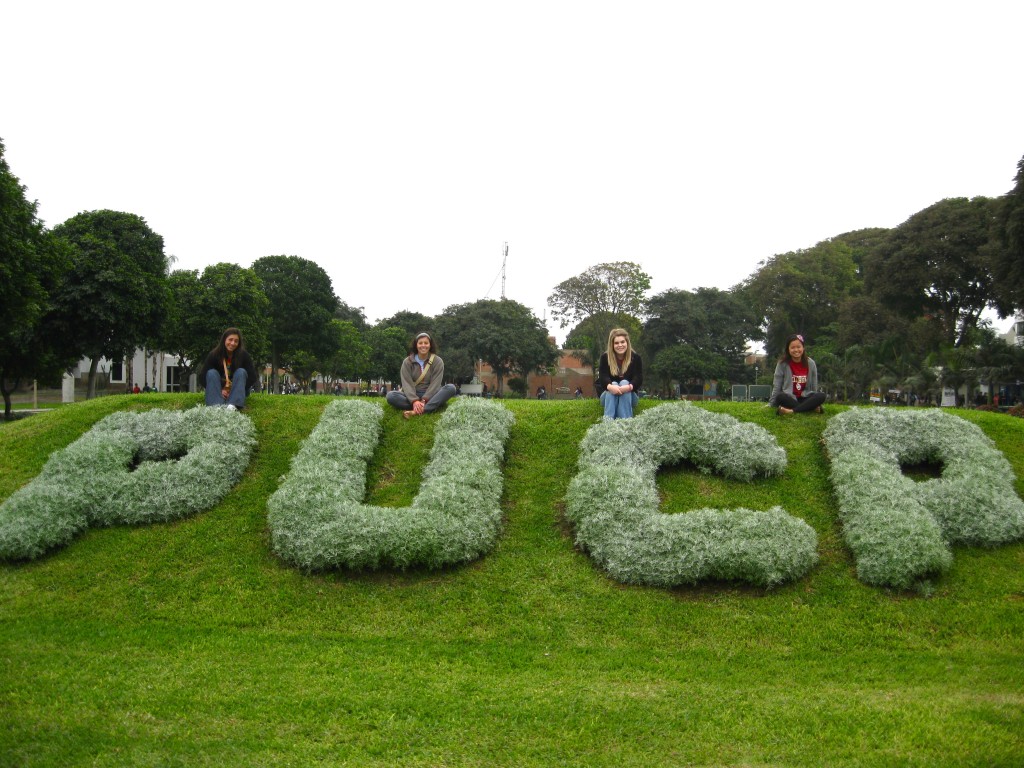
My housemates and I had our last walk to Pontificia Universidad Catolica del Peru. It's our last day in Lima and last class at PUCP.
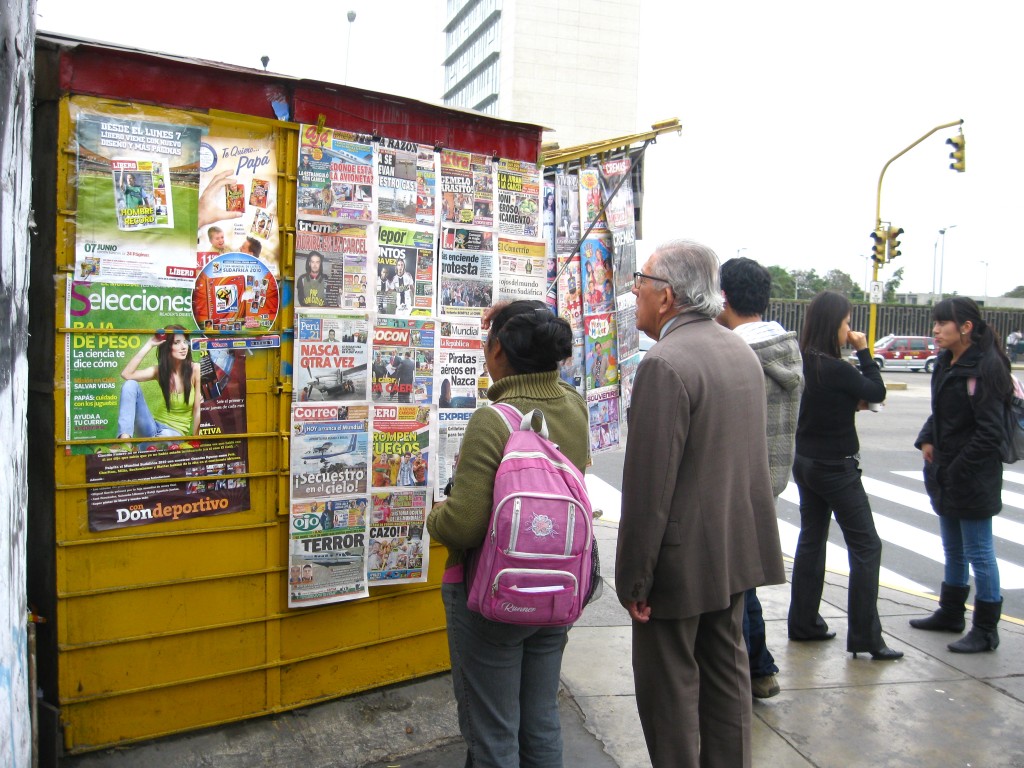
I like to spend time around the newsstands in other countries and observe people’s reaction to the headlines and watch them interact with others around news. Based on my observations, I’ve noticed that news is very important to many countries, Peru being one of them.

We went to the Santa Maria Magdalena Catholic Church in Magdalena, a district of Peru. Unfortunately, the doors were locked, but we were able to see the church with a closer view. It is beautifully adorned in pink and green with an elaborate dome and a statue of Mary on top.
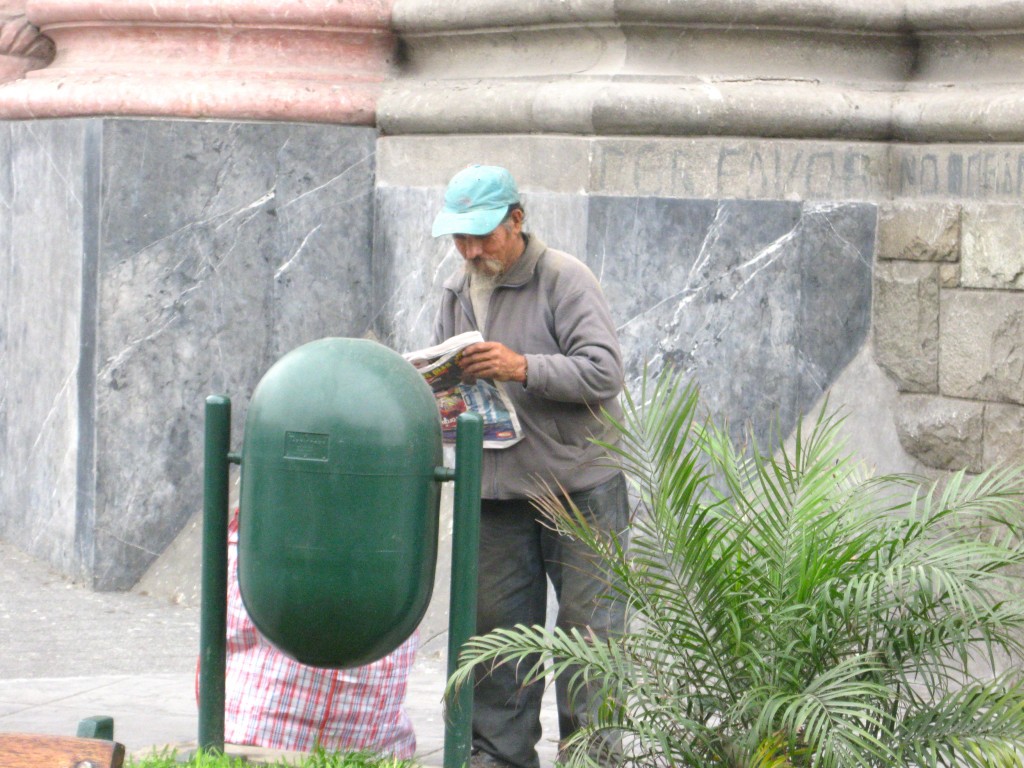
I watched a poor Peruvian man pull a newspaper out from a trashcan to read it. Although he is poor and cannot afford to buy the paper, he has learned of ways to get his news. Watching this man pull the paper out of a trashcan, scan through the pages and put it in his bag reminds me of my reasons to be a journalist: to be the voice and ears to the powerless.
We had our last walk to Pontificia Universidad Catolica del Peru. It’s our last day in Lima and last class at PUCP. I can’t believe we’ve been here 13 days, but I’m excited for Cuzco.
Happy World Cup premiere day! I wish we had more time to watch the World Cup and spend time with Peruvians to see their reaction to soccer, the most popular sport in Peru.
We had a briefing and discussed the observations we’ve had of Lima in today’s final class at Pontificia Universidad Catolica del Peru. We all have learned so much. Many, myself included, had no idea we would learn so much. What a pleasant surprise!
We split up into groups to discuss our observations and had an opportunity to ask Dr. Kenney questions based on our observations and experience thus far. Dr. Kenney knows so much about Peru’s history and culture. Where does he store all this information?
We had capresse, rice with fish, yucca, bell peppers and onions in a flavorful Peruvian sauce and key lime pie for our last cafeteria meal. I’ll miss this campus, but I’m excited for the next two weeks!
We went to the Santa Maria Magdalena Catholic Church in Magdalena, a district of Peru. Unfortunately, the doors were locked, but we were able to see the church with a closer view. It is beautifully adorned in pink and green with an elaborate dome and a statue of Mary on top.
Then we walked around town, found some Incan markets, shopped at San Miguel Plaza, had sweets at Zugatti Gelato & Café and took advantage of our last day in Lima! We also ran into a few of the other ladies of OU Journey to Latin America at the plaza. We later went to Magic City and Casino Miami, casinos by San Miguel Plaza. We ended up not playing any games in the casinos because there wasn’t very many people in them, and we got tired.
Because I am a journalism junkie, I tend to be extra observant and curious of many things. I like to spend time around the newsstands in other countries and observe people’s reaction to the headlines and watch them interact with others around news. Based on my observations, I’ve noticed that news is very important to many countries, Peru being one of them.
People of all social class buy newspapers and magazines from the newsstands in Peru. It seems that non-Americans pay more attention to news than Americans. For example, in tough economic times, newspaper subscriptions and the number of papers purchased tend to decline, yet the Peruvian poor continue to immerse themselves in the news. Many college students purchase the paper. Students usually surround the student-produced newspaper stand at PUCP.
Also, I watched a poor Peruvian man pull a newspaper out from a trashcan to read it. Although he is poor and cannot afford to buy the paper, he has learned of ways to get his news. Watching this man pull the paper out of a trashcan, scan through the pages and put it in his bag reminds me of my reasons to be a journalist: to be the voice and ears to the powerless. I don’t know if he can read or not, but I know he is interested in current events. Although he does not have a job, yet he has learned to make a living by finding reusable things in trashcans. He has also learned to educate himself by picking up a used newspaper and being aware of the world around him. He walked off with the newspaper and a bag (about the size of his body) filled with others’ junk in which he hopes to turn into treasures…or a few soles to make it through another tough day.
I Skyped with Mommy, blogged and e-mailed for what may be the last time in the next two weeks. I don’t know how much Internet I will have in the mountainous regions of Cuzco and in the Amazon, but who’s complaining?
I’m so nervous about high altitude sickness (13,000 ft) and falling while climbing Wayna Picchu (the very top of Machu Picchu, known for people falling and dying). But Dr. Kenney will be with us, so hopefully that will help my nervousness!
We had Chifa (Peruvian-Chinese food) for our last meal in Lima and spent time with our wonderful host mom. She does so much for her husband and two kids, works two jobs and dances–what a woman!
We are packed and watched reruns of the World Cup before going to bed. It was our first time to turn on the TV in two weeks!
Jun
11
A review of Thursday, June 10, 2010
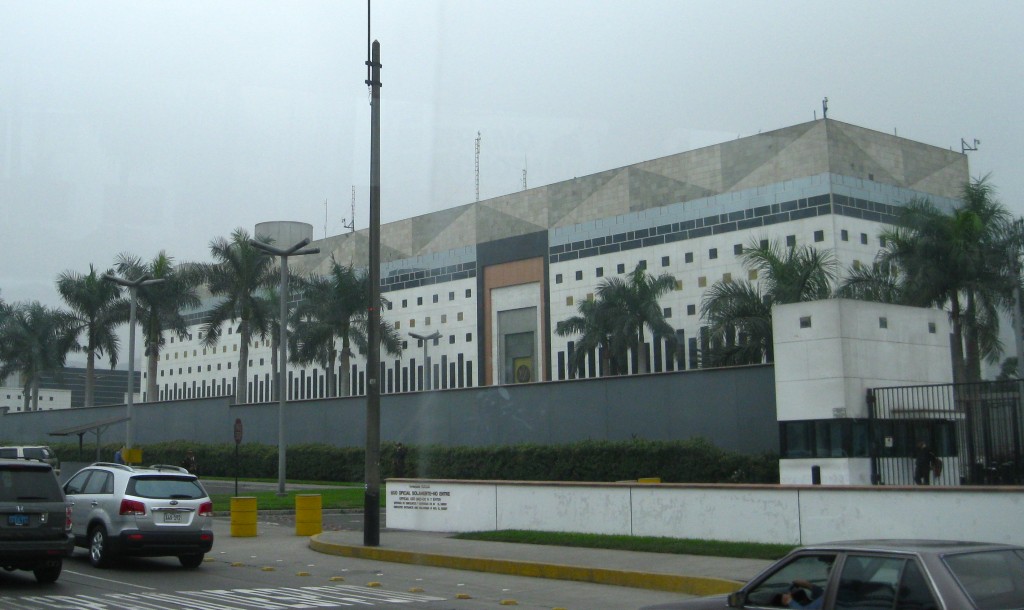
We visited the U.S. Embassy in Lima and met with five officials from different U.S. departments. We all agreed this was one of the most interesting and prestigious experiences so far. The U.S. Embassy in Lima is one of the coolest embassy structures I've seen. A walkway like the Great Wall of China leads to a tall multi-colored stone structure with small, square black glass windows!
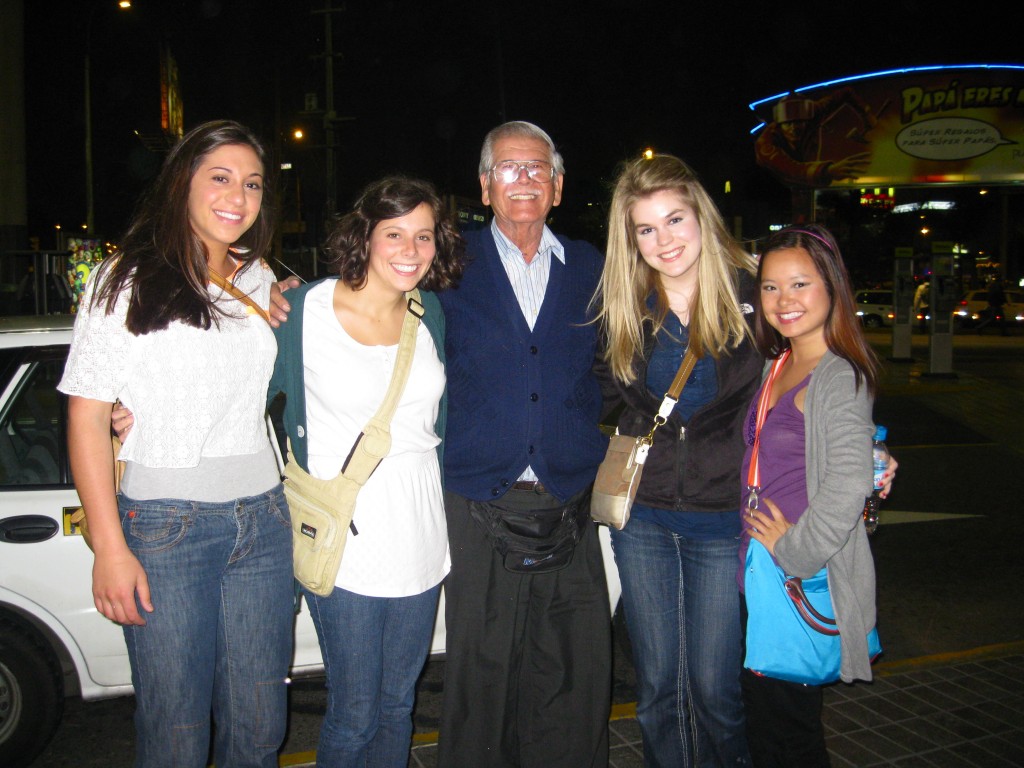
The memories of the taxi drivers blend together after awhile, but I will always remember today’s 63-year-old taxi driver, Ricardo.
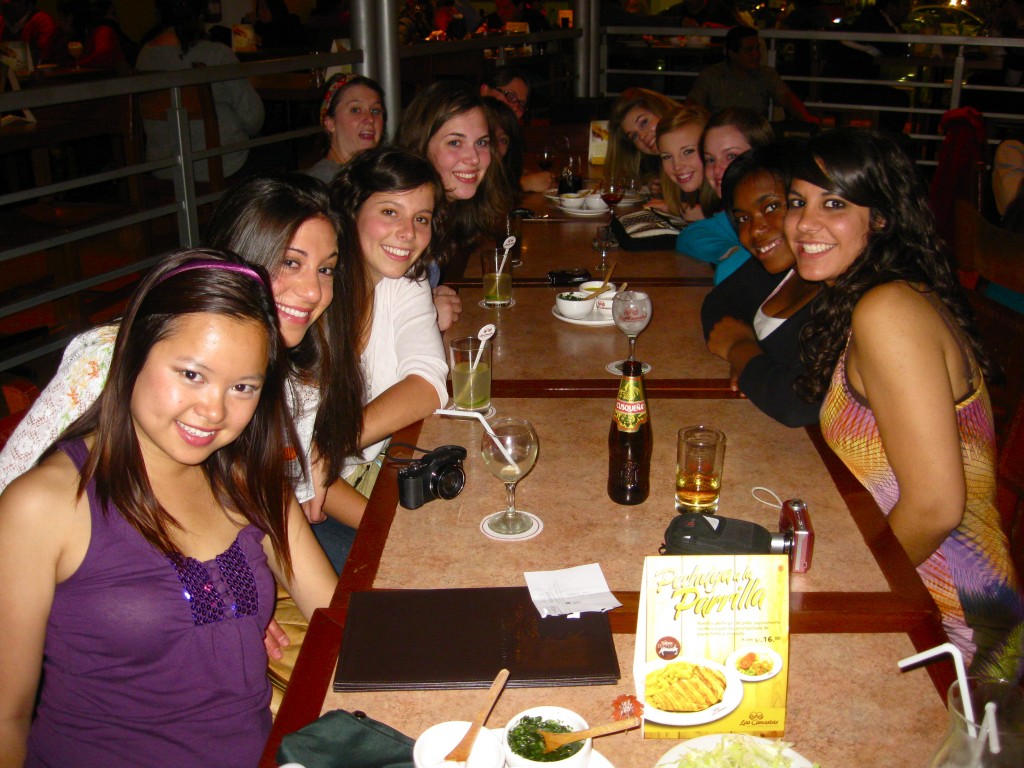
All the girls went to a Peruvian restaurant with our new friend and PUCP alum, Luis—what a lucky feller.
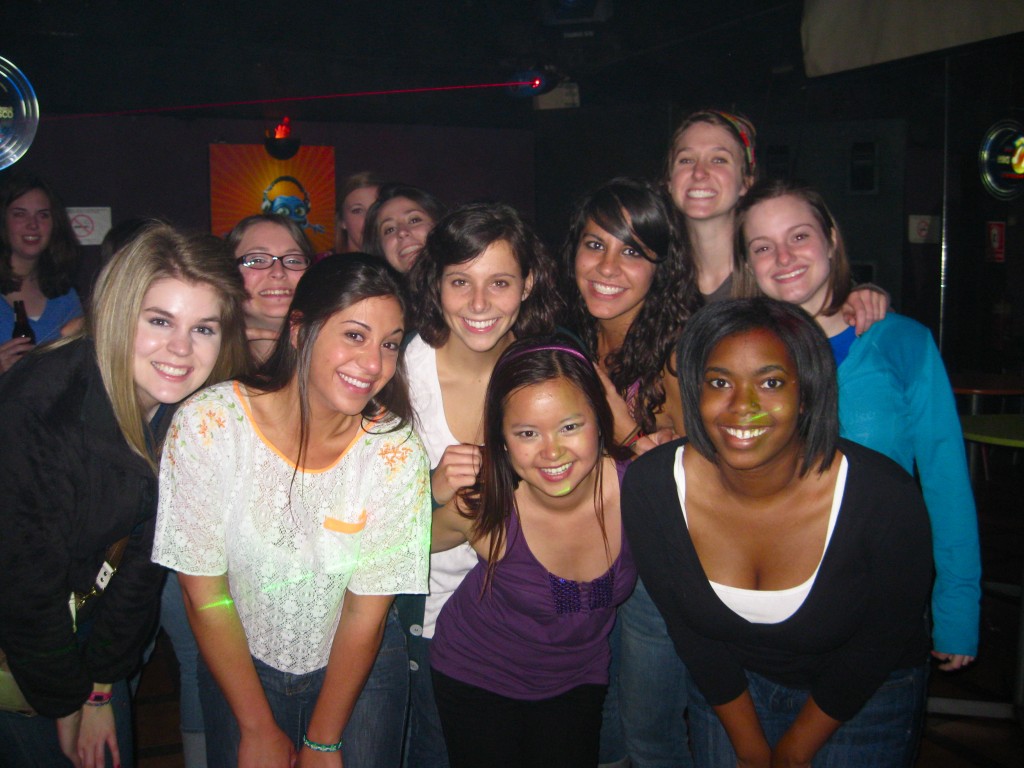
Then we went to La Calle de Pizzas in Miraflores to get our last dose of Lima. We danced at a discoteca. There’s only three discotecas on La Calle de Pizzas that play Latina and American music, and we have been to all three.
Some taxi drivers try to make our prices higher than Peruvians’ just because we are Americans, but I refuse to allow that kind of discrimination (or any kind of discrimination). I’m the queen of bartering thanks to my world-traveling experiences; therefore, I am skilled at getting taxi rides to be the lowest price possible.
It’s probably because people are so intimidated by me. Ha-Ha. Not really. BUT Dr. Kenney said I look Peruvian. And I’ve had numerous Peruvians ask me which Peruvian city I’m from and others speak Spanish to me thinking I’m fluent. I wish!
We learned about Peru’s international relations in today’s class. We had rice with fried eggs and hamburger patties, chicken tamales, chicha (drink made from purple corn with a hint of lime) and rolls for lunch. I can’t believe we have been in Peru for 12 days!
We visited the U.S. Embassy in Lima and met with five officials from different U.S. departments. We all agreed this was one of the most interesting and prestigious experiences so far. The U.S. Embassy in Lima is the coolest embassy structure I’ve ever seen. A walkway like the Great Wall of China leads to a tall multi-colored stone structure with small, square black glass windows! It’s a shame cameras were not allowed past security—that is why I only took 20 pictures today.
Most of us wished we had more time to speak to the officials because they were so informative. We learned a lot within 1.5 hours. What a great and relevant afternoon activity. This is also definitely a rare opportunity. When would we ever be able to speak to these kinds of professionals again? It’s not easy to have a private meeting with U.S. Embassy and foreign relations officials.
An intern my age, Amanda, told us about her experiences while living in Peru for three years at numerous times. Her parents work for the Embassy. I found out she goes to school with my friend Kelsey in Gonzaga, at a small university in Washington. She shared her views with me, and later found me on Facebook. I love meeting new people, connecting with them and continuing relationships.
Our host family made my favorite dish, lomo saltado (rice with beef strips sautéed with onions, tomatoes and potatoes). This is my third time to have this dish in the 12 days I’ve been here, but this time was the best because it had the most flavor AND the host mom added bean sprouts and soy sauce! We also had a Peruvian-style egg drop soup, charo. I’m so sad we only have one more day with our host family!
It’s interesting and fun getting to know the Peruvian taxi drivers. Getting in cars with strangers can be scary, but it’s more reassuring when we talk to them. The age of our taxi drivers have ranged from 28 to 63.
The memories of the taxi drivers blend together after awhile, but I will always remember today’s 63-year-old taxi driver, Ricardo. He drove us from our host home to San Miguel Plaza, an outdoor mall. His personality and hospitality brought me joy in that short amount of time we were together for the taxi ride.
He made an impression on me because of what he stands for. Ricardo, along with many other senior citizens of Peru and around the world, do not have the opportunity to enjoy their later years. He does not have the opportunity to go on cruises with his wife or play with his grandchildren. Why? Because he does not have retirement savings or pension benefits like many Americans do.
No matter how hard Ricardo works, he does not make enough money to save; therefore, he cannot afford to take a day off of work. I am impressed with his ability to drive in this unorganized and unregulated traffic. I’m more impressed with his optimism and ability to support his wife and three children. Not only did Ricardo understand my Spanish clearly, he was willing to put the taxi in park to take a picture with us. Thanks, Abuelo (Spanish term for grandpa, which he gave me permission to call him).
All the girls later went to a Peruvian restaurant with our new friend and PUCP alum, Luis—what a lucky feller. Luis has been Dr. Kenney’s assistant for the past 12 days we have been in Lima. He is an anthropologist. He also works for Pontificia Universidad Catolica del Peru international services department, which is why he helps Dr. Kenney. It was our last time to see him, but only God knows what the future holds.
Then we went to La Calle de Pizzas in Miraflores to get our last night life dosage of Lima. We danced at a discoteca. There’s only three discotecas on La Calle de Pizzas that play Latina and American music, and we have been to all three. We got silly on the dance floor––I think the Peruvians think that’s how we normally dance. Well, they’re correct!
Based on our observations, Peruvians do not go out on Thursday nights (at least where we go) like people go out in the United States. Plus, Peruvians go out at a much later time. We usually go out around 10 p.m., but we do not see many Peruvians until around midnight, when we are headed home. The discotecas, or clubs, are also much smaller. We practically had the entire discoteca to ourselves tonight because we were there earlier than the time Peruvians go out. We still took up the dance floor with our group. These gals are so much fun!
Jun
10
Well, it’s over. It’s a sad fact for me to face, and it has yet to truly dawn on me I think. Four months of my life I spent living the life and now it has come to pass. Now it is nearly time to go back to the old routine. I’ll have to trade in my Shawerma stands for pizza shops, Marshrutka taxis for Norman’s shuttle buses, and the language and culture I have come to love and respect for the ones I was born with. It’s bittersweet. I of course am looking forward to seeing the familiar and closes faces of those I left behind when I embarked on this small adventure, but it was sad to wave goodbye to the new friends I made with an uncertainty as to when I will see them again. And so I think back on all the good times we spent and find it hard to write any words that could capture the moments, but I figure using pictures kind of means I’m writing a thousand words at a time, so here are a few:







Jun
10
This is my first post since arriving in Italy. It has been such a long week. Internet has been hard to come by, so I guess I’ll try to make this one count.
We arrived in Rome on schedule. The flights were fine. Well.. except the part where they wake you up a few hours after you fell asleep and tell you it’s morning. Now… the sun was up and shining, which was very convincing. But my body didn’t agree. The only good part was being handed coffee immediately.
I traveled with 3 girls straight from Oklahoma City. We met up with another girl in Chicago and a fifth once we arrived in Rome. The six of us got a deal on a van to our hotel in the middle of Rome. Well, it went nearly to our hotel. I consider wandering around a city, pulling luggage, being exhausted, and looking clueless is part of the experience. Rome was beautiful. I miss it. I feel like we were there for a long time. Each day, we got up, had some bread and coffee, and started our trek with our professor through the city. The weather was beautiful, but sunny. By the end of the day, we were all covered in sweat and groaning about our feet.
The buildings and art were amazing. There was this moment, while I was looking at a Bernini sculpture, when I realized that this trip was going to be significant for me. I’ve never cared for art history as much as a studio art major should. Seeing the work in person changes everything. Photos in books can be inspiring, but standing near a famous piece of art and realizing there is a reason that it’s famous does more. It’s moving. And then it’s humbling. It makes me feel like I can never be an artist because I need to improve so much. The thing about me, fortunately, is I find being told I can’t do something extremely motivating. Even if I am the one saying it. Oh I can’t? Watch me.
I’m leaving out a lot, but just know the academic side of things has been action packed and the non-class cultural experiences have been a number of things: enlightening, complicated, confusing, and hilarious to name a few.
Next, we took a private bus to Sienna. It was such a nice place. We were only there for an afternoon, but it was worth it. We saw art in a very small museum and then our professor sent us on a mission. In Sienna, there are 17 neighborhoods that all have different animal names and compete in a horse race. We were told to ask locals about their neighborhoods and which neighborhoods were their rivals. It felt like being part of the Amazing Race. Minus the physical labor and plus gelato. There is always gelato involved. I was lucky in that no one was mean to me and several people were very helpful. Some girls said that they were kicked out of stores for asking, even if they had already made purchases.
So far, people have mostly been nice. Lots of people have been unfriendly, but not mean. Some people, specifically men, have been overly welcoming. It’s a strange thing to be blatantly propositioned and (after firmly declining, of course) not even feeling that offended. I think I’d like to deck a guy if he was so blunt in Oklahoma. Here, it is easy to brush off.
We are in Florence now. It smells like cigarettes and leather. And food, if you’re standing in the right places. I like this city. The walls of the buildings are very tall and the streets are very narrow. There are more tourists here than I’ve ever seen in my life. The guides hold sticks with flowers or decorations on the ends or umbrellas to keep from losing their flocks. It’s very strange to be in a foreign place and hear so many American voices around. It isn’t what I expected, but I’m spending time on the beaten path. I wish I had more time here to better get to know the city, but we leave on Friday.
So far, I like both of my courses. The art history professor, Kirk, is great. I think I’ve learned a lot. I doubt I’ll be telling him any time soon, but I credit his teaching style. He calls it practical. I haven’t spent much time with the other professor, Stephanie, since she won’t be with us regularly until we get to Arezzo, but she seems very sharp and kind. These people are great sources of information. This program is one where you get back whatever you put in. I’m doing my best to get a lot back.
I may not have internet for a bit, but I’ll update when I get the chance.
Ciao
Anne
Jun
9


We visited PromPeru for a tour and presentation.
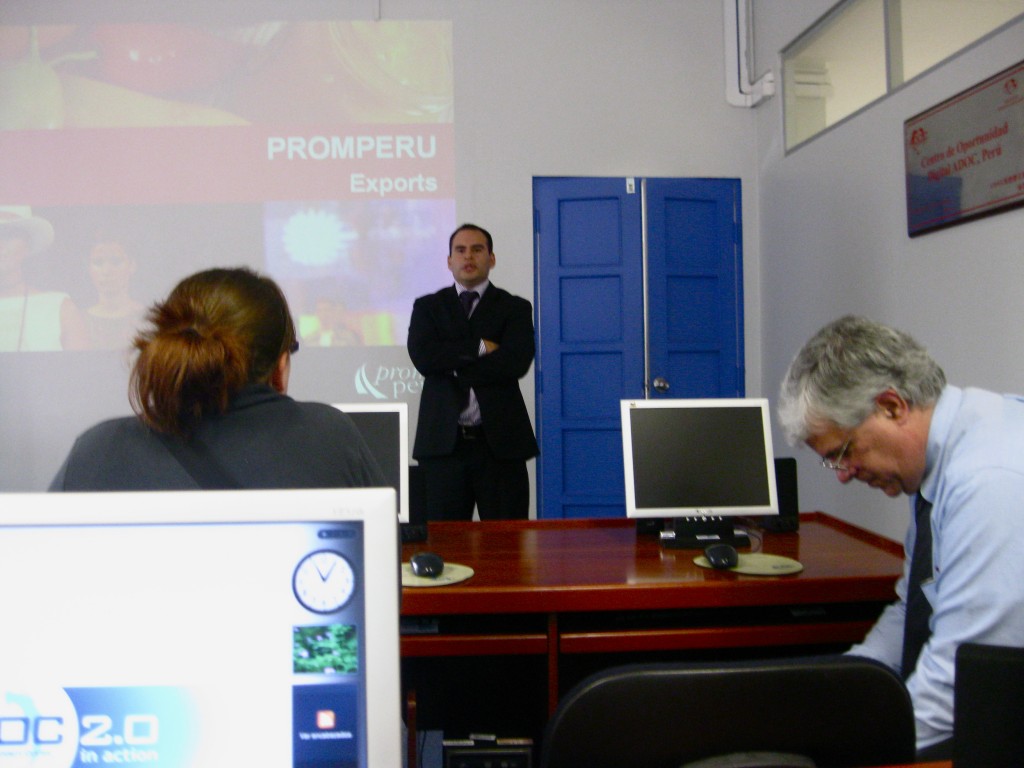
PromPeru gave us a private presentation of their programs and goals.

It's great to see so many citizens attend the workshop to better their economy and living conditions!

This is what a typical class at Ponticia Universidad Catolic del Peru looks like. Notice how attentive we are!
It’s another cloudy day. My clothes are still not dry after three days because it’s been cloudy. And our room smells like wet dogs since it’s covered in wet clothes. Proomie also did laundry, but we managed to fit all our clothes on the unused top bunk.
I miss the American clothes dryer, but I’m in Peru so I can’t complain! Apparently we had a small earthquake overnight–I must have slept through it! I’m such a heavy sleeper.
We started the day earlier at 8 a.m. instead of 9, but I was less sleepy. We visited PromPeru for a tour and presentation. PromPeru is a commission for the promotion of exportation and tourism in Peru. We participated in the workshop that’s free to all, and then an official gave us a private presentation upstairs of PromPeru’s programs and goals. It’s great to see so many citizens attend the workshop to better their economy and living conditions!
We had rice, beef and sweet potatoes with Peruvian sauce drizzled on top, flan and pear juice for lunch. We went to the campus bookstore and bought pens and sweaters.
I bought a Pontificia Universidad Catolica del Peru sweater in a crimson color. Boomer Sooner from PUCP!
We switched things up today and had class in the afternoon instead of morning. I’m not sure that’s a good idea since we usually get sleepy after lunch. We learned about the economy of Latin America in today’s class. It’s nice to be done by 5 p.m. today for a change, but there’s construction next door to our host home. I also miss laws of the U.S.A. That sounds silly, but it seems like there’s not much of law and order here in Peru. There are not (or at least that I know of) any laws about construction work. Construction goes on until late here in Peru…MUST IGNORE DRILLING NOISES.
We had rice, mashed potatoes and chicken with a special Peruvian sauce and caramel crepes and Peruvian ice cream for dinner. The mother of our host mom is such a great cook!
Dr. Kenney had plans with his family, but we enjoyed our host dad’s company. I had a long conversation with Ricardo, our host dad, about traveling and the importance of experiencing the world. He knows all about that since he owns a travel agency. I love practicing Spanish with him because he makes me feel comfortable, and I’m not worried about being wrong.
I jammed to music via my iTunes library with my housemate and watched Usher music videos wishing we were the girls in the videos. Hahaha not really…but Usher is good-looking!
We have bonded so much so quickly! It’s just something about traveling and getting to know a country that makes us all bond.
I can’t believe we have been in Peru for 11 days!
Jun
8

Fr. David, originally from the United States now a Peruvian citizen, visited us at the Peyton Center and spoke about his studies and experiences.
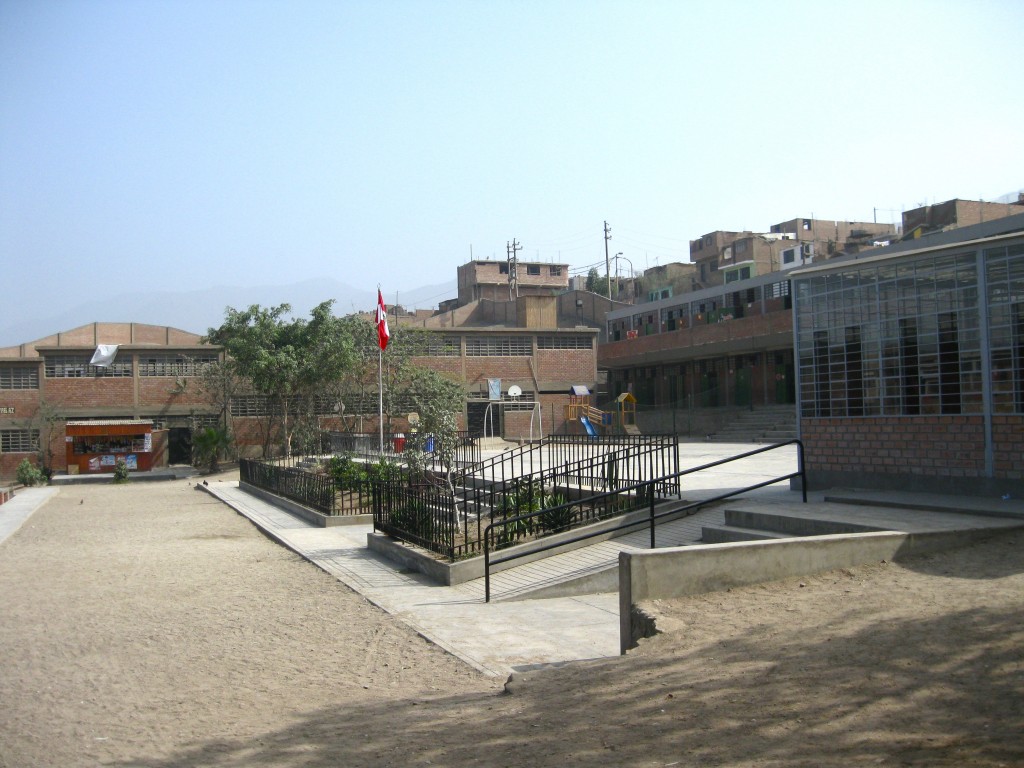
My favorite activity of the day is the visit to Fe Y Alegre No. 25 (Faith and Joy) school. Students there are ages 4 through 17.

The younger students were so precious. I took many pictures of them. They sang and danced for us.

I wanted to take home every child as souvenirs!

I love being around children because they remind us to enjoy the little things in life.

Our last activity of the day was a visit to La Lombriz Feliz (The Happy Worm) ecology center, garden and worm farm in Canto Grande.
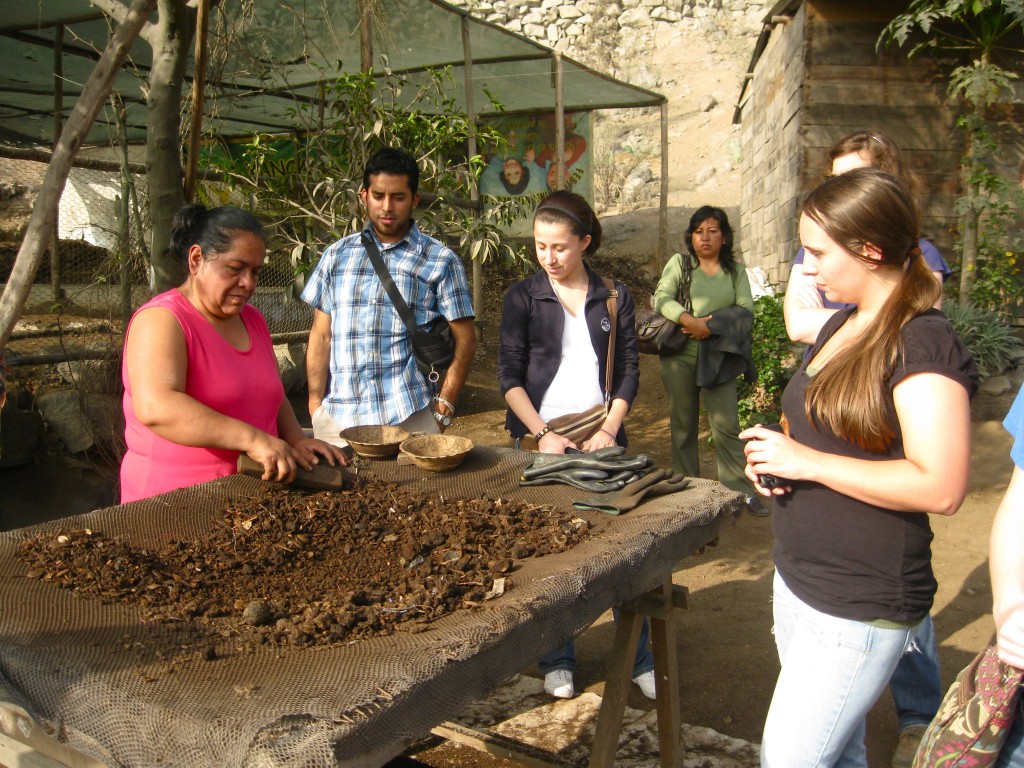
La Lombriz Feliz is in a very poor area once surrounded by trash. Community leaders created this to decrease neighborhood contamination by separating trash by organic (to turn into compost), nonorganic (to recycle) and nonusable (to trash appropriately).

If it weren’t for this ecology center, the neighborhood would not have very much greenery. I’m so glad community leaders thought about their future and came up with an innovative idea for the overwhelming amount of waste.
We had fresh-squeezed orange juice, Angel Flakes (the less tasty version of Corn Flakes), toast and jelly, jam, turkey and cheese for breakfast. We made it through the night with no problem…well, except Whitley went to the bathroom in the middle of the night, Kim and Ashley thought it was an intruder, locked the door and Whitley got locked out so she started knocking and some girls FREAKED OUT and screamed. HAHAHA
After breakfast, Fr. David, originally from The United States now a Peruvian citizen, visited us at the Peyton Center and spoke about his studies and experiences. We were able to spend two days in Canto Grande exploring and learning. Last year’s group spent only one day in Canto Grande. God is good!
Elmer Garcia, a man who grew up in the mountains then later moved to a very poor part of Peru told us his story. He struggled, but became a community leader. A woman from Mexico, Rosalina Sanchez, and a man from Okmulgee (what a small world!) with experiences in helping the Peruvian poor also shared their stories with us. It’s SO inspiring how these common people are doing extraordinary tasks!
The Peyton Center served us rice with beef strips sautéed with onions and tomatoes (this was our first meal in Peru last week and my favorite Peruvian dish); guacamole and Peruvian-style wontons; chocolate cake and Inca Kola for lunch. We have been searching for guacamole, and this was delish!
My favorite activity of the day is the visit to Fe Y Alegre No. 25 (Faith and Joy) school. Students there are ages 4 through 17. The school has two shifts: a morning shift and an afternoon shift. Because the population is so big, the school cannot hold all the students at once. We toured the school, played with the students and learned about their promising programs. I wanted to take home every child as souvenirs! They were so precious. I took many pictures of them. They sang and danced for us. I love being around children because they remind us to enjoy the little things in life.
I was glad to see the school had science labs, a library, big soccer fields, two volleyball courts, a pastoral office and a special education class. I was also overjoyed to see occupational programs such as automobile mechanics, ceramics, weaving and eight others. There are a total of 11 programs students age 13 to 17 may choose from each semester. It’s nice to have these classes as fun “electives,” while also training students for future jobs.
Our last activity of the day was a visit to La Lombriz Feliz (The Happy Worm) ecology center, garden and worm farm in Canto Grande. It is in a very poor area once surrounded by trash. Community leaders created this to decrease neighborhood contamination by separating trash by organic (to turn into compost), nonorganic (to recycle) and nonusable (to trash appropriately).
A bag of 1 kg of compost in a regular bag costs 1 sole, while the same amount of compost in a nicer bag with the brand logo costs 1.5 soles. The money made goes to pay for workers at La Lombriz Feliz and fund services such as the children’s garden. Members of La Lombriz Feliz encourage neighborhood children to learn about gardening and nature while bringing vegetables home to their families. This is especially important in Canto Grande because the area is on a dry hill. If it weren’t for this ecology center, the neighborhood would not have very much greenery. I’m so glad community leaders thought about their future and came up with an innovative idea for the overwhelming amount of waste.
We came back to our host homes in Lima. Dr. Kenney and I discussed how funny it is that we consider our host homes “homes” now after only 10 days. We sure missed our “home,” and were glad to be back. Our host family was welcoming as usual.
We had boiled eggs, mashed potatoes with a Peruvian sauce, avocadoes and soup for dinner…delicious as always!
It’s amazing how different Lima’s weather is just from district to district within a city. Even though it’s winter here, I wore a tank top for the first time since this trip in Canto Grande, yet I am cold now back at our host home.




